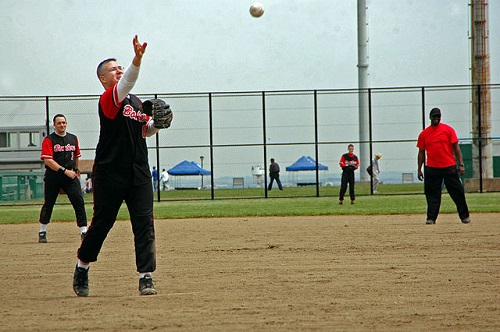Difference Between Slow-Pitch and Fast-Pitch Softball

Slo-Pitch
Slow-Pitch vs. Fast-Pitch Softball
Softball is a popular sport that is divided into two distinct forms or types: the fast-pitch and the slow-pitch. Since both forms fall under the same game, there are many similarities between the two. However, there are also major differences in terms of play and other game- related concepts.
The main difference lies in the speed and manner of putting the ball into play. As their names imply, fast-pitch involves a powerful and fast delivery of the ball. The ball is delivered faster and straighter. This fast and straight manner of delivery across the plate is what makes the ball harder to hit.
In contrast, slow-pitch involves throwing the ball in an arch of 6-12 feet with a moderate ball speed. The ball goes up high and falls on the plate, which makes it easier to hit.
In fast-pitch, the play is dependent on the pitcher and the ball throw. In this type of softball, a powerful pitcher is preferred, because he can deliver a throw with great velocity or create deceptive ball movements to discourage the batter from hitting the ball. In this method, the ball is never received into play since the ball isn’t hit. Another consequence of the pitcher’s objective is to strike the batters out at the plate.
Pitchers in this type of play use a windmill-type motion in throwing the ball, giving it power and speed. The pressure of play is placed on the offensive team (where the pitcher is a member).
On the other hand, slow-pitch play encourages the batter to hit the ball so that it is introduced into play. In this type of play, the pressure is on the defense team rather than the offensive team.

Fastpitch
Fast-pitch softball usually has nine innings in a game. The game is played with nine players. Meanwhile, slow-pitch softball only has seven innings and is played by ten players. The extra player serves as a player in the outfield and a countermeasure in additional hitting and offense.
Fast-pitch games allow base stealing, a practice not permissible in slow-pitch. The player is required to stay on base until the ball is hit. Strikeouts and double plays are also more common in fast-pitch games than in slow-pitch games.
In terms of hitting, fast-pitch allows having a designated hitter for players who cannot perform powerful hits. In slow-pitch, there is no substitution for batting; when a player is already on the plate, she or he must hit the ball.
Summary:
1.Slow-pitch and fast-pitch are two forms of softball. Both forms have identical rules but also many distinguishable features.
2.The main difference is in the manner of throwing the ball. In fast-pitch, the ball is thrown straight or in a windmill-type motion across the plate. The throw is also powerful or involves deceptive movements to make it harder to hit by the opposing team’s batter. On the other hand, slow-pitch involves throwing the ball in an arch and at moderate speed so that the batter can hit the ball.
3.In fast-pitch, the pitcher plays a central role. The main objective of the pitcher is to make sure that the batters don’t hit the ball and to make the batters strike out; the pressure is on the offensive team. Meanwhile, slow-pitch places the pressure on the defensive team after the ball is introduced into play. Slow-pitch encourages the ball to be “in the game.”
4.Fast-pitch games have nine players on the field and played within nine innings. In contrast, slow-pitch involves ten players and seven innings per game.
- Differences Between Fraternity And Sorority - January 8, 2014
- Differences Between Lucite and Plastic - January 7, 2014
- Differences Between Oil and Butter - January 6, 2014
Search DifferenceBetween.net :
Leave a Response
References :
[0]https://en.wikipedia.org/wiki/Ontario_Amateur_Softball_Association
[1]https://www.flickr.com/photos/stevenpisano/14592750099/
